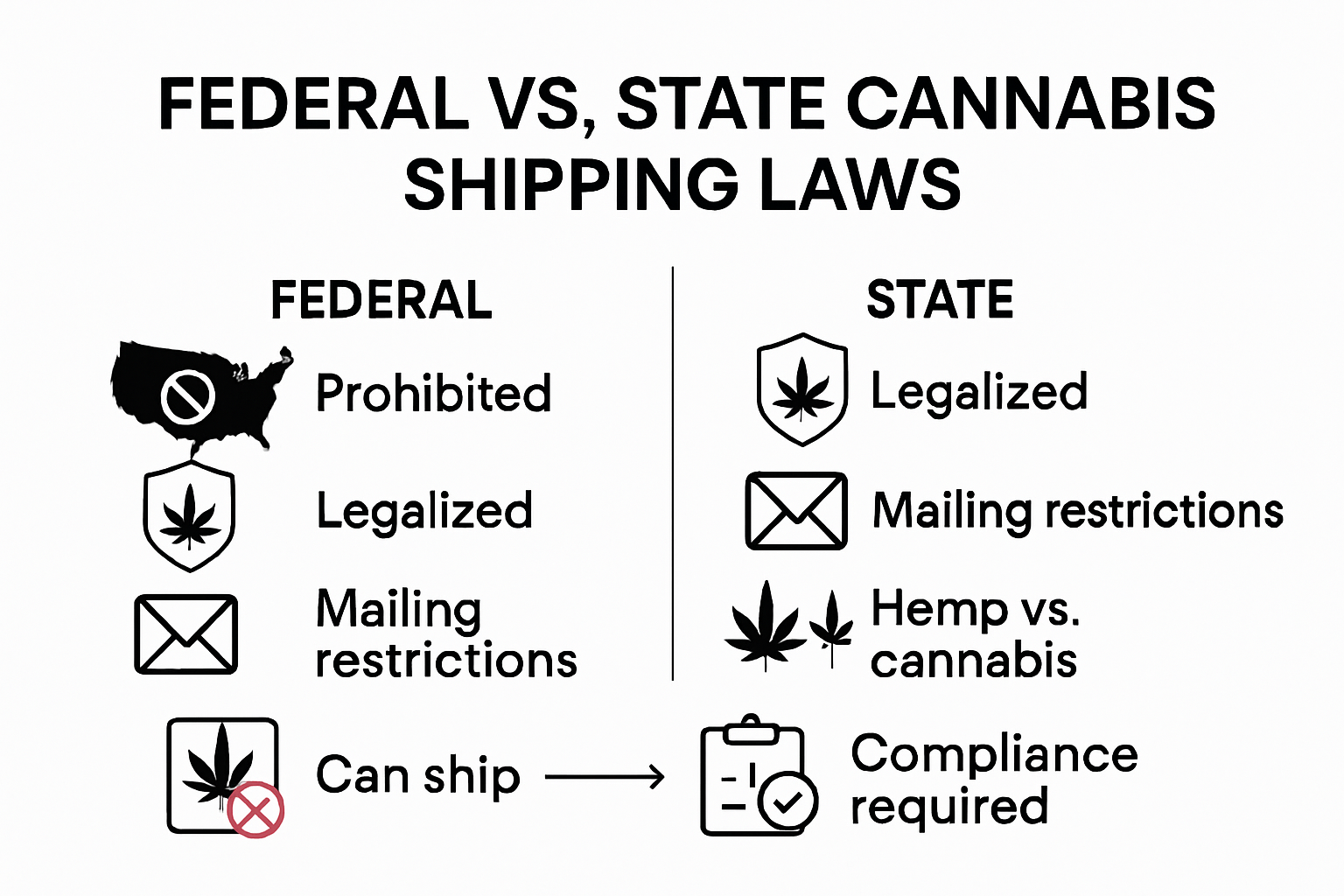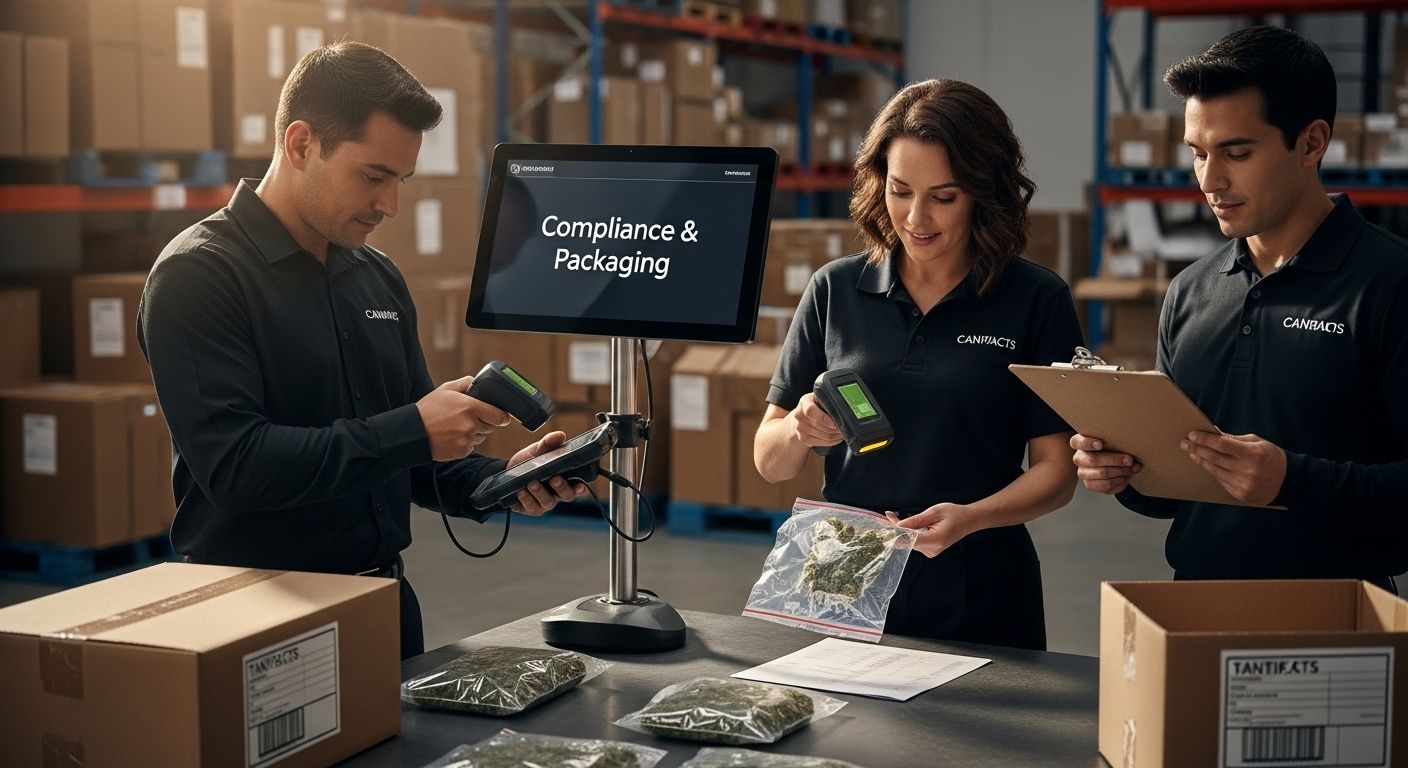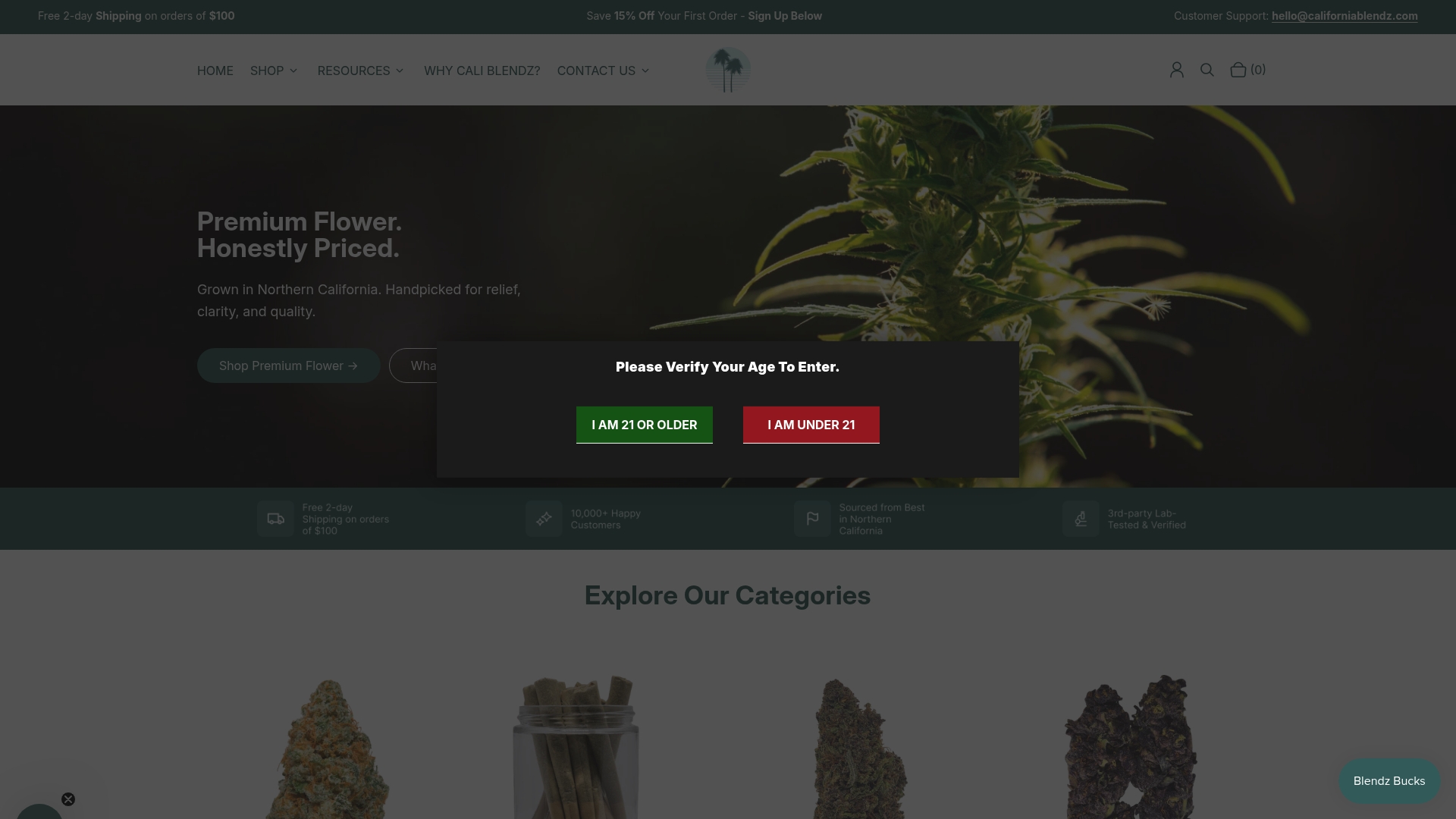Understanding Cannabis Product Shipping Laws: What You Need to Know
Written by California Blendz


Cannabis product shipping laws create a web of rules that can confuse even seasoned experts, especially with 14 states now allowing direct recreational cannabis delivery and 26 plus DC permitting medical cannabis delivery. Most people assume that if something is legal in one state, it must be simple to ship it to another. Not so fast. The real surprise is that crossing state lines with cannabis products is almost always illegal under federal law, no matter how easy local deliveries might seem.
Table of Contents
- Overview Of Cannabis Product Shipping Laws
- Differences Between State And Federal Shipping Rules
- Shipping Guidelines For Cbd, Thca, And Hemp Products
- Practical Tips For Safe And Legal Cannabis Shipping
Quick Summary
| Takeaway | Explanation |
|---|---|
| Understand state-specific regulations | Cannabis shipping laws vary widely by state, requiring careful compliance with local regulations before any shipment. |
| Follow strict packaging requirements | Products must meet specific packaging standards, including child-resistant and opaque containers, to ensure legal shipment. |
| Distinguish between hemp and cannabis | Products containing less than 0.3% THC are classified as hemp and have different shipping regulations than higher-THC cannabis. |
| Navigating federal vs. state laws is crucial | Federal laws prohibit cannabis shipping across state lines, even if it’s legal within some states, complicating logistics. |
| Maintain thorough documentation | Accurate shipping manifests detailing product type, quantity, and compliance are essential to prevent legal issues during transport. |
Overview of Cannabis Product Shipping Laws
Cannabis product shipping laws represent a complex and evolving regulatory landscape that demands careful navigation for businesses and consumers alike. Understanding these regulations is crucial for anyone involved in purchasing, selling, or transporting cannabis and hemp-derived products across different jurisdictions.
Federal and State Regulatory Complexity
The legal framework surrounding cannabis product shipping is characterized by significant variability and intricate restrictions. Learn more about legal hemp transportation to understand the nuanced challenges. According to research from the National Academies of Sciences, cannabis shipping regulations differ dramatically across states, creating a patchwork of legal requirements that can be challenging to comprehend.
As of July 2024, a comprehensive review revealed that shipping regulations vary extensively. Research published in a medical journal found that 14 states authorize direct delivery of recreational cannabis, while 26 states and the District of Columbia permit medical cannabis delivery. This diversity underscores the importance of understanding specific state-level regulations before attempting to ship any cannabis products.
To clearly illustrate the differing legal statuses and restrictions on cannabis product shipping across states, here’s a summary table showing how many states currently allow recreational and medical cannabis delivery:
| Shipping Authorization | Number of States (as of July 2024) |
|---|---|
| Recreational Cannabis Delivery | 14 |
| Medical Cannabis Delivery | 26 |
| District of Columbia (Medical) | 1 |
| Interstate Shipping (Any Type) | Prohibited under federal law |
This table provides a quick overview of the legal landscape for state-authorized cannabis deliveries versus federal restrictions.
Packaging and Compliance Requirements
Strict packaging and labeling standards play a critical role in cannabis product shipping laws. The FDA has issued clear guidelines regarding the legal boundaries of cannabis product marketing and distribution. Only products meeting specific packaging requirements can be legally shipped, with regulations focusing on preventing accidental ingestion and ensuring consumer safety.
Key packaging considerations include:
- Opaque Containers: Designed to prevent visual identification of contents
- Child-Resistant Packaging: Mandatory in most jurisdictions to prevent unintended access
- Clear Labeling: Indicating cannabinoid content, origin, and legal compliance
Interstate Shipping Challenges
Cannabis product shipping remains particularly complex due to federal regulations that classify cannabis as a controlled substance. This classification creates significant barriers for interstate commerce, even in states with legal cannabis markets. Businesses must navigate a complicated legal environment that requires meticulous attention to state-specific regulations, carrier policies, and potential federal interventions.
Transporting cannabis products across state lines remains largely prohibited, with exceptions typically limited to hemp-derived products containing less than 0.3% THC. Companies must invest substantial resources in understanding and complying with these intricate legal requirements to avoid potential legal consequences.
The landscape of cannabis product shipping laws continues to evolve, driven by changing public attitudes, medical research, and ongoing legislative efforts. Staying informed about current regulations and maintaining strict compliance is essential for businesses and consumers engaged in cannabis product transportation.
Differences Between State and Federal Shipping Rules
The legal landscape of cannabis product shipping presents a stark contrast between state and federal regulations, creating a complex and often confusing environment for businesses and consumers. This regulatory divide represents one of the most challenging aspects of cannabis commerce in the United States.
Federal Prohibition vs. State Legalization
The fundamental tension in cannabis shipping laws stems from a critical legal discrepancy. Understand the legal nuances of hemp transportation to grasp the complexity of this issue. According to the U.S. Department of Justice, marijuana remains a Schedule I controlled substance under federal law, regardless of state-level legalization. This means that while individual states may permit cannabis sales and distribution, federal regulations still classify cannabis as an illegal substance.
The FDA explicitly outlines that federal law supersedes state regulations when it comes to cannabis product distribution. This creates a significant legal barrier for interstate shipping, as federal agencies like the United States Postal Service (USPS) and private carriers are bound by federal regulations that prohibit the transportation of cannabis products.
Shipping Restrictions and Legal Complications
State-level cannabis shipping laws vary dramatically, creating a patchwork of regulations that businesses must carefully navigate. The Washington State Liquor and Cannabis Board highlights that federal law strictly prohibits mailing or shipping cannabis, even between states where it is legal. This means that:
- Interstate Shipping: Completely prohibited under federal law
- Intrastate Shipping: Subject to individual state regulations
- Carrier Policies: Most major shipping companies refuse to transport cannabis products
Businesses operating in the cannabis industry must implement sophisticated compliance strategies to avoid legal repercussions. This often involves:
- Maintaining separate shipping protocols for different states
- Carefully verifying customer location and legal status
- Implementing rigorous documentation processes
Hemp vs. Cannabis: A Critical Distinction
One important nuance exists in the shipping regulations for hemp-derived products. Hemp-derived cannabis products containing less than 0.3% THC occupy a different legal space. These products can be shipped more freely, though they still face significant regulatory scrutiny. Businesses must be extremely precise in their product classification and documentation to ensure compliance.
The legal landscape continues to evolve, with ongoing legislative efforts and court challenges constantly reshaping the regulatory environment. Businesses and consumers must remain vigilant, staying informed about the latest developments in cannabis shipping laws. The disconnect between state and federal regulations creates a complex legal terrain that requires careful navigation and expert understanding.
Ultimately, the differences between state and federal shipping rules represent a significant challenge for the cannabis industry. Successful navigation of these regulations requires a comprehensive understanding of both state-specific laws and overarching federal restrictions.

Shipping Guidelines for CBD, THCA, and Hemp Products
Navigating the shipping guidelines for CBD, THCA, and hemp products requires a comprehensive understanding of complex legal regulations and product-specific requirements. Each cannabinoid category presents unique challenges and considerations for businesses and consumers engaged in product transportation.
Hemp and CBD Shipping Regulations
Hemp-derived products containing less than 0.3% THC occupy a distinct legal space in shipping regulations. Explore legal hemp transportation insights to understand the nuanced landscape. According to the USDA national regulatory framework, hemp products must comply with specific production and documentation standards to be eligible for interstate shipping.
The FDA provides critical guidance regarding cannabis-derived product regulations. CBD products face additional scrutiny, with restrictions based on their intended use and marketing claims. Key considerations include:
- Product Composition: Strict THC concentration limits
- Documentation: Comprehensive lab testing certificates
- Packaging: Child-resistant and tamper-evident requirements
THCA Product Shipping Complexities
THCA products present more intricate shipping challenges due to their potential for psychoactive conversion. Discover our THCA collection to understand the product nuances. The National Conference of State Legislatures highlights the variability in state-level regulations governing THCA product transportation.
Shipping THCA products requires meticulous attention to:
- State-specific legal definitions
- Potential conversion to THC during transportation
- Precise documentation of cannabinoid content
Carrier and Compliance Considerations
Most major shipping carriers maintain strict policies regarding cannabinoid product transportation. Businesses must develop comprehensive compliance strategies that include:
- Rigorous verification of recipient age and location
- Detailed product testing and documentation
- Compliance with both state and federal shipping regulations
Carriers typically require:
- Explicit labeling indicating product contents
- Verification of legal status in origin and destination states
- Signed agreements acknowledging regulatory compliance
The shipping landscape for CBD, THCA, and hemp products remains dynamic and complex. Businesses and consumers must stay informed about evolving regulations, maintaining a proactive approach to compliance and risk management. Successful navigation of these guidelines requires continuous education, meticulous documentation, and a thorough understanding of both federal and state-level requirements.
Ultimately, the key to successful shipping of cannabinoid products lies in understanding the intricate legal framework, maintaining transparent documentation, and working closely with knowledgeable shipping partners who specialize in regulated product transportation.

Practical Tips for Safe and Legal Cannabis Shipping
Navigating the complex world of cannabis shipping requires a strategic approach that prioritizes legal compliance, product safety, and regulatory adherence. Businesses and individuals must implement comprehensive protocols to ensure successful and lawful transportation of cannabis products.
Packaging and Documentation Essentials
Learn about proper cannabis storage techniques to understand the fundamental principles of product preservation during shipping. According to Oregon’s Liquor and Cannabis Commission, packaging represents a critical component of legal cannabis shipping. Effective packaging must include:
- Child-Resistant Containers: Mandatory for all cannabis product shipments
- Tamper-Evident Seals: Ensuring product integrity during transportation
- Precise Labeling: Detailing cannabinoid content, origin, and legal compliance
Detailed documentation is equally crucial. Shipping manifests must comprehensively outline:
- Product type and quantity
- Cannabinoid concentration
- Batch and testing information
- Sender and recipient verification details
To help businesses and consumers quickly identify key packaging and documentation requirements for legal cannabis shipping, here is a checklist table based strictly on guidelines mentioned in the article:
| Requirement | Description | Required? |
|---|---|---|
| Child-resistant packaging | Prevents unintended access, especially by children | Yes |
| Opaque containers | Conceals product contents from view | Yes |
| Tamper-evident seals | Ensures packaging integrity during transport | Yes |
| Clear labeling | Includes content, origin, legal compliance info | Yes |
| Complete shipping manifest | Outlines product, quantity, testing, parties involved | Yes |
| Laboratory test certificates | Proves THC content and product safety | Often |
| Age & recipient verification | Confirms legal status of recipient | Yes |
This table serves as a practical reference for essential shipping compliance items, ensuring that all necessary steps are followed for legal cannabis transportation.
Transportation Compliance Strategies
Transportation protocols vary significantly across jurisdictions. Understand legal hemp transportation nuances to grasp the complexity of shipping regulations. The Virginia Cannabis Regulations provide insights into comprehensive transportation requirements:
- Generate detailed transport manifests
- Securely transmit documentation to receiving facilities
- Maintain sealed and labeled packaging throughout transportation
- Implement GPS tracking for shipments
- Utilize temperature-controlled transportation methods
Shipping carriers often impose additional restrictions, requiring businesses to:
- Verify recipient age and legal status
- Obtain explicit carrier agreements
- Maintain comprehensive compliance documentation
Risk Mitigation and Best Practices
New York’s regulatory framework, as outlined by state cannabis transportation guidelines, emphasizes robust risk management strategies. Key considerations include:
- Conducting thorough background checks on transportation personnel
- Implementing secure communication protocols
- Developing comprehensive emergency response plans
- Maintaining rigorous record-keeping systems
- Regularly updating compliance training
Additional risk mitigation strategies involve:
- Working exclusively with licensed shipping partners
- Maintaining robust insurance coverage
- Conducting periodic internal compliance audits
- Staying informed about evolving regulatory landscapes
Successful cannabis shipping requires a multifaceted approach that combines legal knowledge, meticulous documentation, and proactive risk management. Businesses must remain adaptable, continuously educating themselves about changing regulations and implementing robust compliance frameworks.
Ultimately, the key to safe and legal cannabis shipping lies in understanding the intricate regulatory environment, maintaining transparent operations, and prioritizing product integrity and legal compliance throughout the transportation process.
Frequently Asked Questions
What are the main differences between federal and state cannabis shipping laws?
Federal laws classify cannabis as a controlled substance, making interstate shipping illegal, regardless of state legalization. State laws vary widely on shipping regulations, with some allowing direct delivery of medical or recreational cannabis while others prohibit it altogether.
What packaging requirements must be followed for shipping cannabis products?
Cannabis products must be packaged in child-resistant and opaque containers with clear labeling detailing cannabinoid content and legal compliance. Tamper-evident seals are also essential to ensure product integrity during transportation.
How do shipping laws differ for hemp-derived products like CBD compared to high-THC cannabis?
Hemp-derived products containing less than 0.3% THC have different shipping regulations and can be transported more freely than high-THC cannabis, which remains illegal to ship across state lines under federal law.
What documentation is necessary for legal cannabis shipping?
Shipping manifests detailing product type, quantity, cannabinoid concentration, and compliance information are essential for legal shipping. Comprehensive lab testing certificates may also be required to verify THC content and product safety.
Take the Stress Out of Cannabis Shipping Regulations
Confused by all the legal roadblocks around shipping hemp and cannabis products? If you want high-quality CBD or THCa without risking compliance issues, you are not alone. This article highlights how easy it is to feel overwhelmed by packaging rules, documentation requirements, and changing state laws. At California Blendz, we turn these pain points into peace of mind by offering only legal, lab-tested products. Every order is delivered safely and in line with current shipping and labeling mandates.

Shop confidently from our extensive CBD Flower or discover premium THCa Collection knowing that each step follows strict legal and quality standards. Visit California Blendz now to find trusted cannabis products that put legal compliance and your wellness first. Make your next purchase worry-free and get the relief or experience you deserve today.
Recommended
- Understanding the Legalities of Getting Pulled Over with Legal Hemp: W – California Blendz
- What You Should Know About CBD Product Labeling – California Blendz
- The Ultimate Guide to safely buy CBD flower online – California Blendz
- Understanding THC Content in CBD Flower: What You Need to Know – California Blendz
- Health and Safety in Logistics: Essential Guide for UK Businesses 2025 - BHA Couriers








